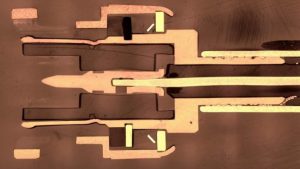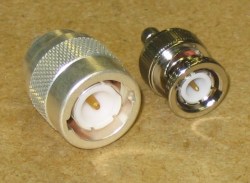
When I started working in a video production house in the early 1980s, it quickly became apparent that there was a lot of snobbery in terms of equipment. These were the days when the home video market was taking off; the Format War had been fought and won by VHS, and consumer-grade VCRs were flying off the shelves and into living rooms. Most of that gear was cheap stuff, built to a price point and destined to fail sooner rather than later, like most consumer gear. In our shop, surrounded by our Ikegami cameras and Sony 3/4″ tape decks, we derided this equipment as “ReggieVision” gear. We were young.
For me, one thing that set pro gear apart from the consumer stuff was the type of connectors it had on the back panel. If a VCR had only the bog-standard F-connectors like those found on cable TV boxes along with RCA jacks for video in and out, I knew it was junk. To impress me, it had to have BNC connectors; that was the hallmark of pro-grade gear.
I may have been snooty, but I wasn’t really wrong. A look at coaxial connectors in general and the design decisions that went into the now-familiar BNC connector offers some insight into why my snobbery was at least partially justified.
Keeping the Impedance
The connector that would eventually become known as the BNC connector when it was invented in the 1950s has its roots in two separate connectors developed in the 1930s and 1940s for the burgeoning radio and telephone industries. When it comes to wires and connectors for DC and low-frequency AC circuits, pretty much anything that will carry the current and provide a firm mechanical connection will do. But once a circuit is into the radio frequency range it’s a different story. At such frequencies coaxial cable is preferred for transmission line, and any connectors inserted into the line need to be engineered to minimize changes in impedance, which could cause reflection of the signal and generate standing waves that can cause damage.

Paul Neil, an electrical engineer who had been with the Bell Company since 1916, was well versed in RF systems. In the 1940s he identified a need for a coaxial connector capable of working well at microwave frequencies and designed the Type N connector. Like all coaxial connectors, it was designed to present as little change in the characteristic impedance of the feedline as possible by keeping the spacing between the center conductor connection and the outer shell as close to the feedline dimensions as possible. Neil’s connector had a female threaded outer shell on the plug that mated with male threads on the matching socket, and was designed to be weatherproof. The N connector took its name from Neil’s last initial and is still in use to this day.

Meanwhile, an engineer at Amphenol Corporation was working on his own design. Carl Concelman’s connector, similarly dubbed the Type C connector, used the same approach to reduce impedance changes in coaxial connections. However, he chose to make his connector quick-disconnect; rather than tediously screwing and unscrewing the outer shell, the C connector had a bayonet connection. The outer shell of the socket had lugs diametrically opposed on its outer surface. These lugs would mate with the long arm of L-shaped grooves machined into the inner surface of the outer shell on the plug. The shell would be rotated to move the lugs into the short arm of the groove, locking the two connectors together mechanically and electrically.385
Best of Both Worlds

Both the N and the C connectors enjoyed success in the marketplace, but neither was ideal. The N connector was slimmer in profile than the C but had all that pesky threading and unthreading to deal with; the C connector has that nice quick-disconnect but was bulky. In addition, neither connector was particularly easy to manufacture as each required some fairly fancy machining. With those shortcomings in mind, an engineer at the Hazeltine Electronics Corporation named Octavio Salati came up with his own design. It would have the bayonet locking feature of the C connector and the slimmer profile of the N connector. It used the same techniques as both connectors to minimize reflections due to inline impedance changes.
Salati’s connector was patented in 1951 with the unexciting name “Electrical Connector.” Unlike its predecessors, it would not be dubbed the “S-Connector” but, in a gentlemanly gesture, it was called the BNC, for “Bayonet Neil-Conselman.” To support the RF work for which it was originally designed, the connector had a 50-ohm characteristic impedance; later, a 75-ohm version was made for the television industry. The connector is usable up to around 11 GHz, although it’s not ideal past 4 GHz or so owing to the slots cut into the conductor for the outer shield, which start to radiate signals.
The BNC connector has seen widespread acceptance as a coaxial connector in industries far beyond its original target markets. From public service communications to scope probes to computer networking, Salati’s design, and by extension both Neil’s and Conselman’s, has delivered solid performance for the past sixty years.
